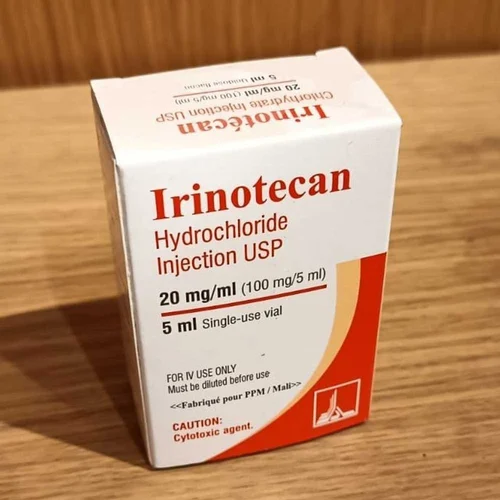💊 DESCRIPTION
Irinotecan HCl trihydrate is a semisynthetic derivative of camptothecin, used as an intravenous antineoplastic agent. It works as a topoisomerase I inhibitor and interferes with DNA replication in cancer cells.
- Form: Sterile solution for injection
- Concentration: 20 mg/mL
- Presentation: Vial (usually 2 mL, 5 mL, or 15 mL depending on total dose)
- Route: Intravenous (IV) infusion only
- Indications:
- Metastatic colorectal cancer (mCRC) – as monotherapy or with 5-FU and leucovorin (FOLFIRI regimen)
- Off-label: Small cell lung cancer, cervical cancer, gastric cancer, pancreatic cancer
✅ ADVANTAGES
- Highly effective in advanced and metastatic colorectal cancer
- Can be used as first-line or second-line treatment
- Synergistic with 5-FU/leucovorin, enhancing response rates
- Active in tumors resistant to other chemotherapies
- Predictable pharmacokinetics and dosage adjustments possible
🌿 NATURE
- Drug Class: Topoisomerase I inhibitor
- Mechanism of Action:
- Irinotecan is a prodrug converted in the liver to SN-38, its active metabolite
- SN-38 inhibits topoisomerase I, preventing DNA uncoiling and replication
- Causes single-strand DNA breaks, leading to cell cycle arrest and apoptosis
- S-phase specific cytotoxic agent
⚠️ PRECAUTIONS
- Severe Diarrhea:
- Early-onset (within 24 hours): Cholinergic – managed with atropine
- Late-onset (after 24 hours): Secretory – managed with loperamide
- Myelosuppression:
- Risk of neutropenia, anemia, and thrombocytopenia – monitor CBC regularly
- Hepatotoxicity:
- Use cautiously in patients with liver dysfunction; monitor LFTs
- Pulmonary Toxicity: Rare but serious – watch for respiratory symptoms
- Hypersensitivity: Infusion reactions possible
- Pregnancy Category D: Contraindicated – teratogenic
- Lactation: Avoid – excreted in breast milk
- UGT1A1*28 polymorphism: May increase toxicity – consider genotyping in high-risk populations
🧊 STORAGE
- Before opening:
- Store at 2–8°C (36–46°F), refrigerated
- Protect from light and freezing
- After dilution (in infusion bag):
- Stable for 24 hours at room temperature or 48 hours refrigerated
- Use only within this period
- Discard unused portions properly (cytotoxic waste)
👨⚕️ PATIENT ADVICE
- Infusion-related side effects (e.g., flushing, abdominal cramping) may occur – notify nurse immediately
- Report any watery diarrhea, fever, bleeding, mouth sores, or severe weakness
- Keep well-hydrated to prevent dehydration from diarrhea
- Avoid crowded places and sick people due to risk of infection
- Use contraception during and after treatment
- Do not take OTC medications for diarrhea unless advised
- Avoid grapefruit juice – may affect metabolism
- Regular blood tests are necessary to monitor for toxicity
📦 PACKAGING
- Primary Packaging:
- Type I glass vial containing 20 mg/mL solution
- Sealed with rubber stopper and flip-off cap
- Vial sizes: Usually available in 2 mL (40 mg), 5 mL (100 mg), 15 mL (300 mg)
- Secondary Packaging:
- Outer carton with product leaflet
- Clearly labeled with:
- Strength (20 mg/mL)
- Total volume and total dose (e.g., 5 mL = 100 mg)
- Batch number, expiry date
- Storage instructions
- “Cytotoxic – handle with care”

